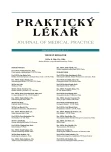Základy kognitivní, afektivní a sociální neurovědy
III. Agrese a násilné chování
Authors:
F. Koukolík
Authors‘ workplace:
Primář: MUDr. František Koukolík, DrSc.
; Národní referenční laboratoř prionových chorob
; Fakultní Thomayerova nemocnice s poliklinikou, Praha
; Oddělení patologie a molekulární medicíny
Published in:
Prakt. Lék. 2011; 91(3): 123-126
Category:
Editorial
Overview
The nature of human aggression can be adressed by considering of Tinbergen’s four ethological questions:
- functional explanation,
- phylogenetic origin,
- developmental origin and modification through experience, and
- mmediate causes.
Is homicidium an adaptation or is it not? What is a function of homicidal fantasies?
Phylogenetic origins of aggression is tied to its evolutionary function. Aggression can be observed throughout the animal kingdom. The neural circuits that underlie aggressive behaviour lie in the forebrain, midbrain and hindbrain.
Key words:
aggression, evolution, ethology, phylogenesis.
Sources
1. Anderson, C.A., Bushman, B.J. Human aggression. Annu Rev. Psychol. 2002, 53, p. 27-51.
2. Archer, J. The behavioural biology of aggression. Cambridge UK: Cambridge University Press, 1988.
3. Archer, J. The nature of human aggression. Int. J. Law. Psychiatry 2009, 32, p. 202-208.
4. Bjorkvist, K., Osterman, K., Lagerspetz, K.M. Sex differences covert aggression among adults. Aggressive Behavior 1994, 20, p. 27-33.
5. Blair, J.R. The role of orbital frontal cortex in the modulation od antisocial behavior. Brain Cogn. 2004, 55, p. 198-208.
6. Booij, L., Tremblay, R.E., Leyton, M. et al.Brain Serotonin Synthesis in Adult Males Characterized by Physical Aggression during Childhood: A 21-Year Longitudinal Study. PLoS ONE 5(6): e11255. doi:10.1371/journal.pone.0011255 (2010)
7. Buss, D.M., Duntley, J.D. The evolution of aggression. In Schaller M, Kernick DT, Simpson JA (vyd.) Evolution and social Psychology. New York: Psychology Press, 2006, p. 263-285.
8. Caspi, A., McClay, J., Moffitt, T.E. et al. Role of genotype in the cycle of violence in maltreated children. Science 2002, 297, p. 851-854.
9. Coté, S.M., Vaillancourt, T., Leblanc, J.C. et al. The development of physical aggression from toddlerhood to pre-adolescence. A nationwide longitudinal study of Canadian children. J. Abnorm. Child. Psychol. 2006, 34, p. 71-85.
10. Daly, M., Wilson, M. Homicide. New York: Aldine de Gruyter, 1988.
11. Daly, M., Wilson, M. Killing the competition. Female/female and male/male homicide. Hum. Nat. 1990, 1, p. 81-107.
12. Daly, M., Wilson, M. Risk taking, intrasexual competition, and homicide. Nebr. Symp. Motiv. 2001, 47, p. 1-26.
13. Duntley, J.D., Buss, D.M. The evolution of evil. In: The social psychology of good and evil. Miller AG (ed). New York–London: Guilford Press, 2004, p. 102-123.
14. Duntley, J.D., Buss, D.M. The origins of homicide. In J. Duntley and T. Shackelford (vyd.), Evolutionary Forensic Psychology. New York: Oxford University Press 2008, p. 41-64.
15. Hamilton, W.D. The genetical evolution of social behavior I, II. J. Theor. Biol. 1964, 7, p. 1-52.
16. Hare, R.D., Neumann, C.S. Structural models of psychopathy. Curr. Psychiatry Rep. 2005, 7, p. 57-64.
17. Hermans, E.J., Ramsey, N.E., van Honk, J. Exogenous testosterone potentiates response to angry facial expression in the neural circuitry of reactive aggression in humans. Biol. Psychiatry 2008, 63, p. 263-270.
18. Kenrick, D.T., Sheets, V. Homicidal fantasies. Ethol. Sociobiol. 1993;14, p. 231-246.
19. Koukolík, F. Neuronální koreláty agrese a násilného chování. In.: Sociální mozek. Praha: Karolinum, 2006, s. 243-262.
20. Koukolík, F. Evoluce a evoluční teorie pro lékaře. VIII. Evoluce lidského mozku. Prakt. lék. 2010, 90, 8, s. 451-454.
21. Koukolík, F. Funkční systémy lidského mozku. Galén, Praha 2011 (v tisku), kapitola Emoce.
22. Maynard-Smith, J. Evolution and the theory of games. Cambridge and New York: Cambridge University Press, 1982.
23. Moyer, K.E. The psychobiology of aggression. New York: Harper and Row Publishers, 1976.
24. Pessoa, L. On the relationship between cognition and emotion. Nat. Rev. Neurosci. 2008, 9, p. 148-158.
25. Prasad, M.R., Kramer, L.A., Ewing-Cobbs, L. Cognitive and neuroimaging findings in physically abused preschoolers. Arch. Dis. Child. 2005, 90, p. 82-85.
26. Simonoff, E., Elander, J., Holmshaw, J. et al. Predictors of antisocial personality. Continuities from childhood to adult life. Brit. J. Psychiatry 2004, 184, p. 118-127.
27. Tinbergen, N. On the aims and methods of ethology. Z Tierpsychol. 1963, 20, p. 410-433.
28. Victoroff, J. Aggression, science, and law: the origins framework. Int. J. Law Psychiatry. 2009, 32, p. 189-197.
29. Volavka, J. The neurobiology of violence: an update. J. Neuropsychiatry Clin. Neurosci. 1999; 11, p. 307-313.
30. Wilson, E.O. Sociobiology. Cambridge: Harvard University Press, 1975.
31. WHO: World report on violence and health. WHO, Geneva 2002
Labels
General practitioner for children and adolescents General practitioner for adultsArticle was published in
General Practitioner

2011 Issue 3
- Memantine Eases Daily Life for Patients and Caregivers
- Hope Awakens with Early Diagnosis of Parkinson's Disease Based on Skin Odor
- Metamizole vs. Tramadol in Postoperative Analgesia
- Memantine in Dementia Therapy – Current Findings and Possible Future Applications
- Metamizole at a Glance and in Practice – Effective Non-Opioid Analgesic for All Ages
Most read in this issue
- Nontuberculous mycobacteria
- A case report of a male with distinctive cervical lymphadenopathy of unknown aetiology
- Current trends in care for facial cleft affected child
- Smoking and nutrition
